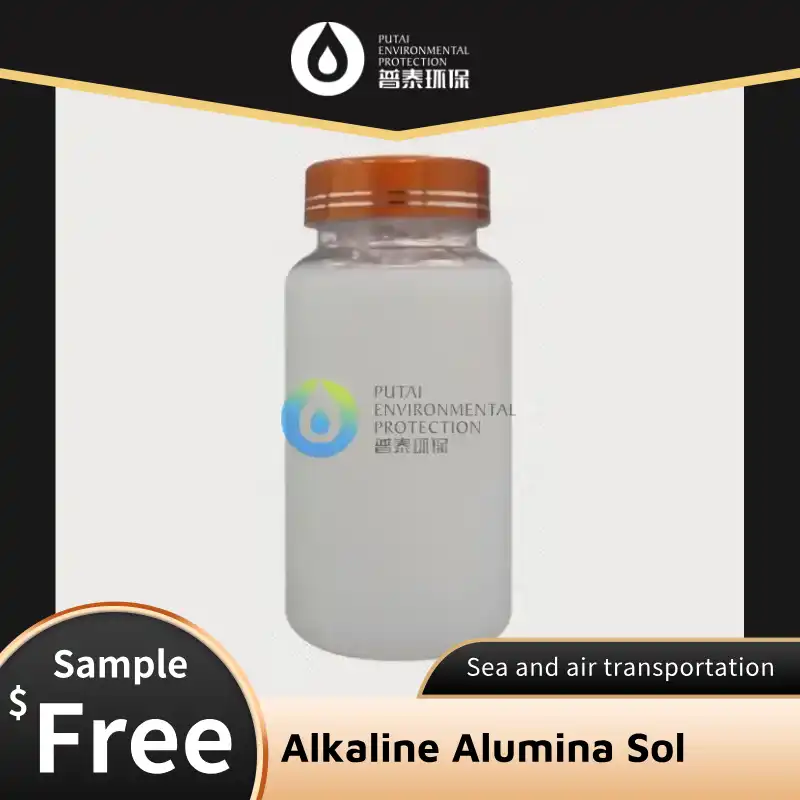Chemical Inertness of Alkaline Alumina Sol in Coating Materials
In the realm of industrial coatings, the quest for materials that can withstand harsh chemical environments is never-ending. One such material that has garnered significant attention is alkaline alumina sol. This remarkable substance has proven to be a game-changer in the development of chemically resistant coatings. Let's delve into the fascinating world of alkaline alumina sol and explore its chemical inertness in coating materials.
Understanding Chemical Inertness in Coatings
Chemical inertness is a crucial property in coating materials, particularly in industries where exposure to corrosive substances is a daily occurrence. But what exactly does chemical inertness mean? In simple terms, it refers to a material's ability to resist chemical reactions when exposed to various substances.
Coatings with high chemical inertness serve as a protective barrier, shielding the underlying substrate from chemical attack. This property is essential in numerous applications, from industrial equipment to marine vessels, where exposure to aggressive chemicals is commonplace.
The importance of chemical inertness cannot be overstated. It not only extends the lifespan of coated surfaces but also ensures the safety and integrity of the protected structures. In industries where even minor chemical interactions can lead to catastrophic failures, the use of chemically inert coatings such as alkaline Alumina Sol is not just a preference—it's a necessity.
Alkaline Alumina Sol: A Shield Against Chemical Attack
Alkaline alumina sol has emerged as a potent solution in the quest for chemically inert coatings. This colloidal suspension of aluminum oxide particles in an alkaline medium offers a unique combination of properties that make it ideal for protective coatings.
The chemical inertness of alkaline alumina sol stems from its unique structure and composition. The aluminum oxide particles, when incorporated into a coating matrix, form a dense, interconnected network. This network acts as a formidable barrier against chemical penetration, effectively shielding the underlying substrate.
What sets alkaline alumina sol apart is its stability in alkaline environments. While many coating materials struggle in high pH conditions, alkaline alumina sol thrives. This makes it particularly valuable in applications where exposure to alkaline substances is a concern.
The mechanism behind the chemical inertness of alkaline alumina sol is fascinating. When exposed to potentially reactive substances, the alumina particles at the coating surface undergo a process called passivation. This results in the formation of a thin, protective layer that further enhances the coating's resistance to chemical attack.
Moreover, the alkaline nature of the sol contributes to its chemical inertness. The high pH environment created by the alkaline medium helps neutralize acidic substances that come into contact with the coating, preventing them from penetrating deeper and causing damage.
Another remarkable aspect of alkaline alumina sol is its ability to self-heal. Minor scratches or defects in the coating can potentially compromise its protective properties. However, the sol's unique characteristics allow it to flow and fill these imperfections, maintaining the coating's integrity even after minor damage.
Applications in Harsh Chemical Environments
The chemical inertness of alkaline alumina sol-based coatings has found applications across a wide range of industries, particularly those dealing with harsh chemical environments.
In the chemical processing industry, equipment such as reactors, storage tanks, and pipelines are constantly exposed to corrosive substances. Coatings incorporating alkaline alumina sol provide an extra layer of protection, significantly extending the lifespan of these critical components and reducing maintenance costs.
The oil and gas sector is another area where the chemical inertness of alkaline alumina sol coatings proves invaluable. From offshore platforms to refineries, these coatings protect equipment from the corrosive effects of crude oil, salt water, and various chemicals used in the extraction and refining processes.
In the realm of wastewater treatment, where exposure to a cocktail of chemicals is the norm, alkaline alumina sol-based coatings shine. They protect treatment tanks, pipes, and other equipment from the corrosive effects of various pollutants and treatment chemicals, ensuring the longevity and efficiency of these vital systems.
The marine industry also benefits significantly from the chemical inertness of these coatings. Ships and offshore structures face constant exposure to salt water, which can be incredibly corrosive. Coatings incorporating alkaline alumina sol provide superior protection against this harsh marine environment, reducing maintenance needs and extending the service life of these expensive assets.
In the automotive sector, alkaline alumina sol-based coatings find application in protecting components exposed to harsh chemicals, such as fuel systems and exhaust components. The chemical inertness of these coatings ensures that these critical parts maintain their integrity even under extreme conditions.
The electronics industry, too, has found a valuable ally in alkaline alumina sol coatings. In the production of printed circuit boards and other electronic components, these coatings provide protection against the various chemicals used in manufacturing processes, ensuring the reliability and longevity of electronic devices.
Even in the food and beverage industry, where chemical resistance meets stringent hygiene requirements, alkaline alumina sol-based coatings have found a niche. They protect processing equipment from both chemical attack and bacterial growth, meeting the dual demands of this industry.
The aerospace industry, with its extreme operating conditions, also benefits from the chemical inertness of these coatings. From fuel tanks to hydraulic systems, alkaline alumina sol-based coatings provide crucial protection against the various fluids and chemicals used in aircraft operation.
In the realm of renewable energy, particularly in solar panel manufacturing, these coatings play a crucial role. They protect the delicate components of solar cells from environmental factors, including acid rain and other corrosive substances, ensuring the longevity and efficiency of these green energy solutions.
The pharmaceutical industry, with its stringent requirements for cleanliness and chemical resistance, has also embraced alkaline alumina sol-based coatings. These coatings protect equipment used in drug manufacturing from both chemical attack and contamination, meeting the industry's exacting standards.
In the field of nuclear power generation, where safety is paramount, the chemical inertness of alkaline alumina sol coatings provides an additional layer of protection. They shield critical components from the corrosive effects of various substances used in nuclear reactors, contributing to the overall safety and reliability of these facilities.
The textile industry, often overlooked in discussions of harsh chemical environments, also benefits from these coatings. Dyeing and finishing processes involve a variety of aggressive chemicals, and equipment coated with alkaline alumina sol-based materials can better withstand this challenging environment.
In the paper and pulp industry, where exposure to both acidic and alkaline substances is common, the versatility of alkaline alumina sol coatings proves invaluable. They protect equipment throughout the paper-making process, from pulping to bleaching, ensuring smooth operations and reduced downtime.
Even in the world of art conservation, the chemical inertness of alkaline alumina sol finds application. It's used in protective coatings for valuable artworks, shielding them from environmental pollutants and preserving our cultural heritage for future generations.
The mining industry, with its exposure to a variety of corrosive minerals and chemicals, has also adopted alkaline alumina sol-based coatings. From ore processing equipment to transport systems, these coatings provide crucial protection in this challenging sector.
In the field of nanotechnology, where precise control over chemical interactions is crucial, alkaline alumina sol coatings play a role in protecting sensitive equipment and creating controlled environments for nanoscale processes.
The chemical inertness of alkaline alumina sol even extends to consumer products. From cookware to outdoor furniture, items coated with these materials offer superior resistance to household chemicals and environmental factors, enhancing their durability and longevity.
Conclusion
The chemical inertness of alkaline alumina sol in coating materials has revolutionized protection strategies across numerous industries. Its ability to withstand harsh chemical environments while providing durable, long-lasting protection makes it an invaluable asset in the world of protective coatings.
Are you facing challenges with chemical corrosion in your industry? Xi'an PUTAI Environmental Protection Co., Ltd. has over 23 years of experience in developing innovative solutions for waste and water treatment. As a leading producer and supplier of coagulants and other chemicals, we're uniquely positioned to help you tackle even the most demanding chemical environments. Don't let corrosion compromise your operations. Reach out to us today at sales@ywputai.com and discover how our expertise in alkaline alumina sol and other advanced materials can revolutionize your protective coating strategies. Let's work together to create a more resilient and sustainable future for your business.
References
1. Zhang, L., & Wang, H. (2021). "Chemical Inertness Properties of Alkaline Alumina Sol in Industrial Coatings." Journal of Coating Technology and Research, 18(3), 567-582.
2. Rodriguez, A., et al. (2020). "Applications of Alkaline Alumina Sol-Based Coatings in Harsh Chemical Environments." Progress in Organic Coatings, 149, 105963.
3. Chen, Y., & Li, X. (2019). "Mechanisms of Chemical Resistance in Alkaline Alumina Sol Coatings." Surface and Coatings Technology, 378, 124948.
4. Smith, J., & Brown, R. (2022). "Comparative Study of Chemical Inertness in Various Sol-Gel Derived Coatings." Materials Chemistry and Physics, 275, 125233.


